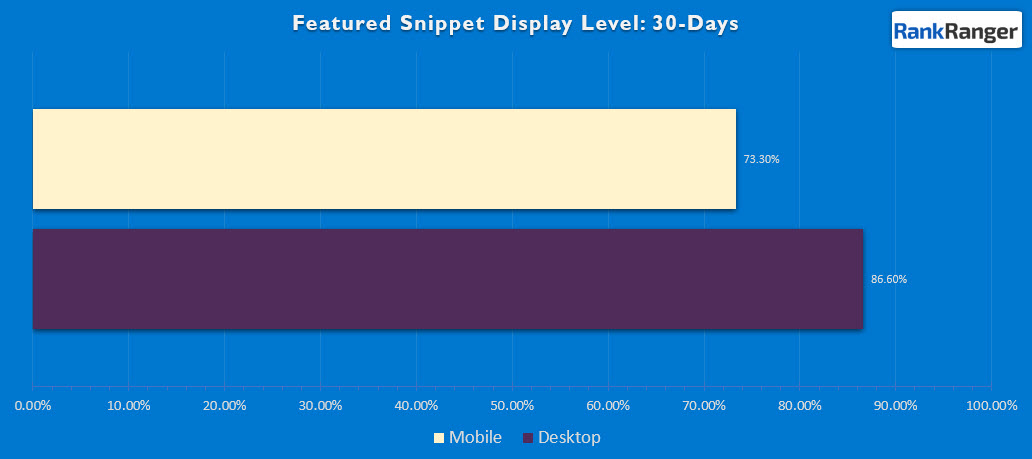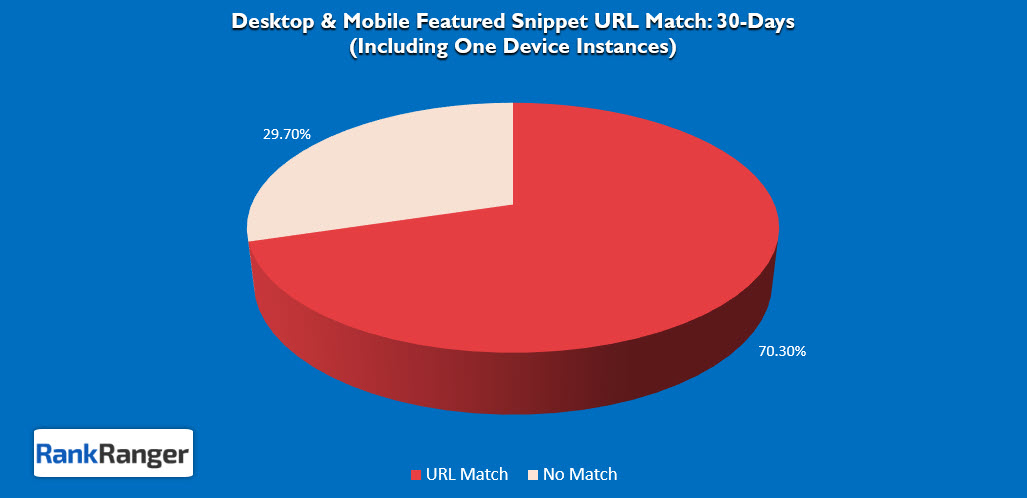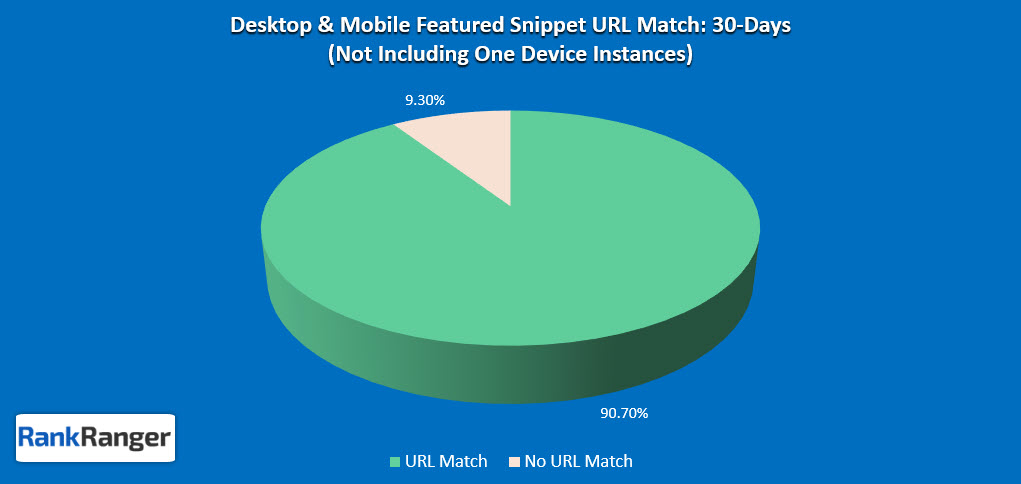Posted by
Mordy Oberstein
So you’ve won a Featured Snippet on desktop, does that mean your URL shows within the zero-position box on mobile? How often does the URL that resides within a mobile Featured Snippet match the desktop URL? Does a Featured Snippet even exist on desktop? What is the likelihood that a Featured Snippet win on desktop equals a Featured Snippet win on mobile?
Here’s a look at how often Google shows the same URL on desktop and on mobile. (Plus, see how consistently URLs perform within the Featured Snippet on desktop versus mobile!)
Does Google Use the Same Featured Snippet URL on Both Desktop & Mobile?
Does Google use the same URLs for both mobile and desktop Featured Snippets? It’s a pretty straightforward question. If you want a more sophisticated take on the question you might ask, does Google see user intent so differently on mobile versus desktop that it does not use the same Featured Snippet URLs? We could even get philosophical with it and wonder aloud if Google should or should not use the same URLs for both mobile and desktop Featured Snippets?
Let’s start off nice and slow with some of the main findings and how I and my crack team went about this study. [Huge thank you to Levi Genesove for his help gathering the data for this study!]
Check out our guide to winning SERP features.
Key Findings and Study Method
We looked at 265 keywords that produced Featured Snippets on desktop and compared the URLs within them to their mobile versions. Specifically, we tracked the URL within a Featured Snippet over a 30-day period and recorded the percentage of days during the period where the URL was consistent across both devices. This recording also included instances where there was a Featured Snippet on desktop but a lack of one on mobile.
[Note, and for the record, my starting point was desktop. That is, as opposed to looking at keywords that had a mobile Featured Snippet and comparing the URL trends to desktop, I took keywords that had a desktop Featured Snippet and compared the URL tendencies to mobile.]
The key findings from this process are:
- Over a 30-day period, the keyword dataset produced a desktop Featured Snippet 86.5% of the time but just 73.3% of the time on mobile.
- Factoring in instances where on a given day a keyword produced a desktop Featured Snippet but not a mobile snippet resulted in the URL matching 70% of the time during the 30-day period studied.
- Discounting instances where a keyword produced a desktop but not a mobile Featured Snippet, the percentage of URLs that matched across both devices through the 30-day period jumped to 90%.
Diving into the Data on Cross-Device URL Consistency
Let’s ease into this by going a bit “top-level” and seeing how consistent Google’s Featured Snippet showing is on both mobile and desktop. In other words, once we know Google tends to show a Featured Snippet for a keyword on both mobile and desktop how consistently is that snippet shown on the SERP over 30-days?

Clearly, Google is a bit more consistent with its desktop Featured Snippets. Over a 30-day period, Google showed a mobile Featured Snippet just 73% of the time compared to 87% of the time on desktop. Meaning, when we looked at each day over a 30-day period, Google only placed a mobile Featured Snippet on the SERP for 73% of those days. On desktop, those same 30-days produced a Featured Snippet 87% of the time for the exact same keywords. [Again, and just to be clear, the dataset includes keywords known to produce a Featured Snippet, it does not factor in instances where a keyword does not produce a Featured Snippet at all.]
On any given day, you are more likely to end up in the desktop Featured Snippet than you are the mobile Featured Snippet simply because there is a substantially larger chance that Google will display a desktop snippet relative to a mobile snippet.
Featured Snippet URL Matchup – Here Comes the Data!
Knowing how consistently Google shows both a Featured Snippet on mobile and desktop is actually an integral part of analyzing how often the URLs on both devices align. Certainly, if on a given day Google shows a Featured Snippet on desktop but not on mobile there can’t be a URL match!
Now, there are two ways to slice this:
1) You could include the days where one device shows with a Featured Snippet while the other does not and count that as a ‘non-match’. The advantage of doing that is it showcases the true power of winning a Featured Snippet from a cross-device perspective. In plain English, considering days where one device has a snippet and the other does not as being an instance where the snippet URLs do not match helps you gauge the overall power of a Featured Snippet win.
2) When considering non-matches, you could discount instances where one device produces a Featured Snippet and the other does not. Doing so would let you know how symbiotic the relationship between desktop and mobile Featured Snippets is. This construct is more of a “pure URL” perspective in that it showcases how Google thinks of Featured Snippet URLs and just Featured Snippet URLs across both devices. This is because other factors such as if there should even be a Featured Snippet for a given keyword on a given day are not accounted for within such a dataset.
What I’m trying to say is that there are reasons to include instances when Google shows a Featured Snippet on desktop but not on mobile as a non-match and reasons to only look at instances where both devices produced a Featured Snippet when analyzing URL matches.
Of course, being a thorough person, I did both.
Desktop and Mobile Featured Snippet URL Matches: Including One Device Instances

The data here includes instances where one device did show a Featured Snippet on a given day and where one device did not produce a Featured Snippet. As is seen, there is a nice chunk of a 30-day period where your Featured Snippet win is not universal. Over the course of a month, your URL that resides within a Featured Snippet will only show on both desktop and mobile 70% of the time. That means that 30% of the time your Featured Snippet win is indeed a win, but just on one device.
From a practical perspective, this data is very telling. If you want to know how far-reaching a desktop Featured Snippet win is, the above data is your friend. (I say “desktop” because as I’ve already alluded, you could approach this from a mobile-centric perspective.) But what does it mean in terms of how Google thinks about Featured Snippet URLs on desktop vs. how it thinks about them on mobile?
For that, we need to discount the instances where only desktop produced a Featured Snippet. This way we can match up URLs one-to-one and see how device-specific Google’s Featured Snippet URL treatment actually is. (In other words, doing so discounts Google’s consideration of showing a Featured Snippet on a given device altogether and solely focuses on URL treatment once Google “decides” to show a snippet on both devices.)
Desktop and Mobile Featured Snippet URL Matches: Excluding One Device Instances

The percentage of Featured Snippet URL matches over a 30-day period picks up quite a bit once you remove instances where the SERP feature displayed only on desktop. In other words, there is a very strong URL alignment between the mobile Featured Snippet and the desktop Featured Snippet. The URL Google shows within its desktop Featured Snippets matches that shown within mobile Featured Snippets 90% of the time once you discount those instances where mobile did not produce the SERP feature. On days where both devices show with a Featured Snippet for a keyword, you can expect Google to use the same URL 9 times out of 10.
This means that the real disparity between Featured Snippet scorings across the two devices has less to do with URLs per se and far more to do with when Google considers the Featured Snippet relevant on each device.
On Featured Snippet Varying Device Relevancy & URL Uniqueness
The idea of a Featured Snippet, its content and URL, being more relevant to a particular device is… odd. Once a keyword is material for a Featured Snippet I have a hard time seeing how ‘device’ comes into play. There are certainly instances where mobile intent and mobile usage differ from that on desktop. I personally make it a habit not to purchase things on mobile as I like to have full screen/site visibility. However, Featured Snippets are entirely informational. The entire idea is to offer the user a snippet of quickly digestible info. In this scenario, it’s hard for me to see why there would be the 13 percentage point discrepancy between mobile and desktop “snippet consistency” (which results in the overall URL matching between devices to be significantly wide).
I don’t have any words of wisdom here, to be honest. I simply find it a bit baffling why there would be greater Featured Snippet consistency on one device over the other. It wasn’t like I could see some sort of observable pattern among the keywords we analyzed. There’s no apparent rhyme or reason to any of this that pops out at you.
What’s more is that even when Google does show both a desktop and mobile Featured Snippet, the URLs don’t match nearly 10% of the time! Now, you might say (as Featured Snippet experts Nigel Stevens and Izzi Smith did) that 10% seems low. The proposition that Google should show entirely unique URLs within Featured Snippets on mobile is provoking, I get it and it makes a ton of sense. Despite that, at the end of the day, I just don’t see user intent for how to___________ being that different on each device. A 10% disparity seems a bit high for me.
The Featured Snippet Fallout: Takeaways

The bottom line is that just because you score a Featured Snippet on one device does not mean your URL has spread its wings on another. It’s not automatic, not anywhere close to it. Over the course of a month, the average keyword will not produce a Featured Snippet with the same URL across both devices 30% of the time. That’s an important number to consider when thinking about the potential traffic a Featured Snippet offers your site. More importantly, when you see your URL within both a mobile and a desktop Featured Snippet you have to realize that there could be a significant amount of time each month where it’s not the case (30% on average).
At 30% it’s certainly worth your while to research Featured Snippet patterns for a keyword over time in order to observe how consistent the snippet is across both devices. The data presented here is an average. There are going to be keywords that produce Featured Snippets with more consistent as well as less consistent cross-device appearances. Knowing which keyword is which from a device consistency perspective could create for a more efficient Featured Snippet strategy.
Happy Featured Snippet hunting!
[For more research on Featured Snippet URLs be sure to look at my study on Featured Snippet market share.]

